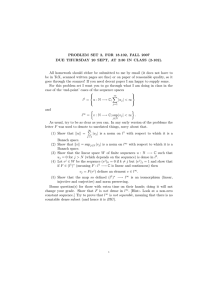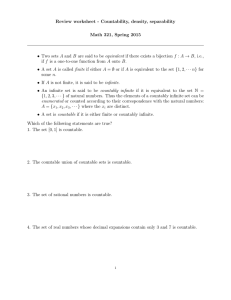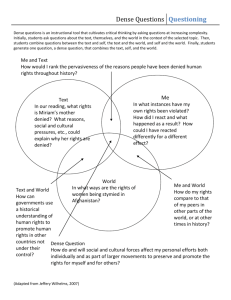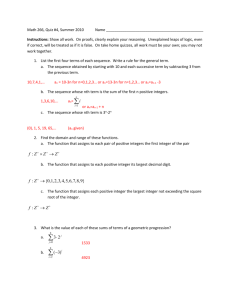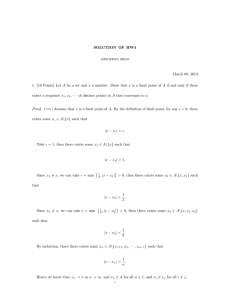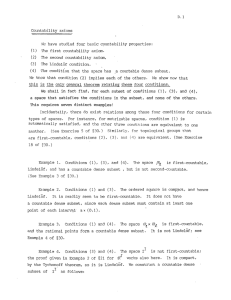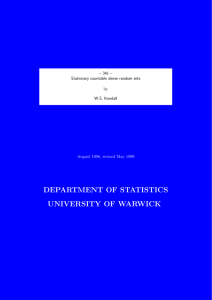Math 515 Professor Lieberman November 8, 2004 HOMEWORK #11 SOLUTIONS
advertisement
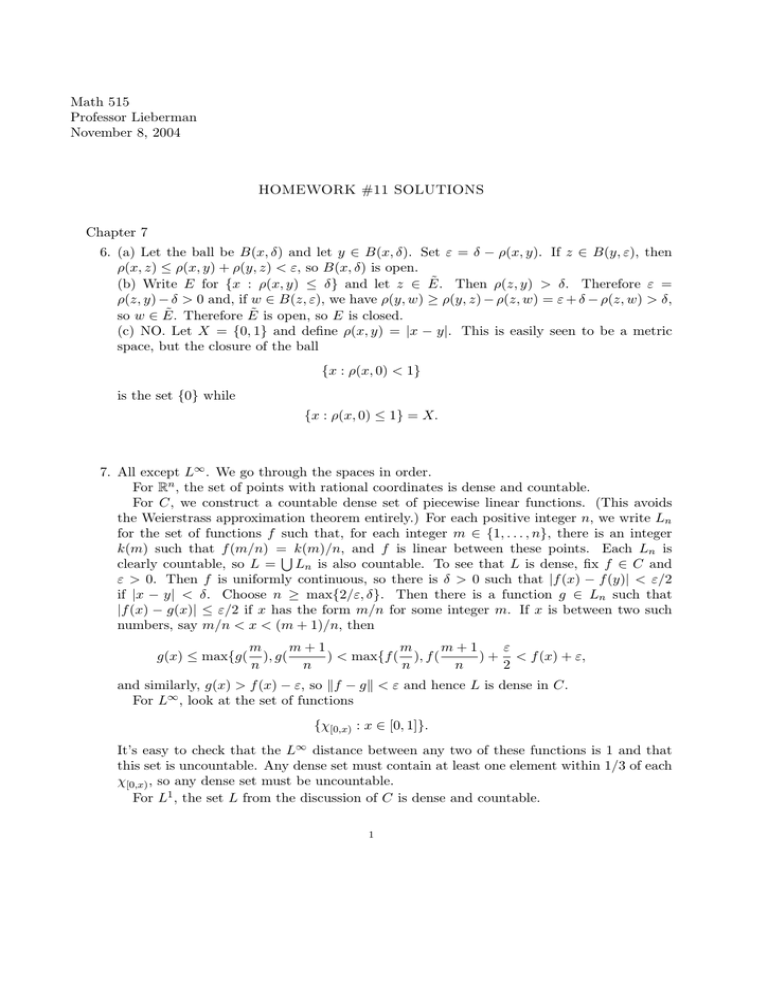
Math 515
Professor Lieberman
November 8, 2004
HOMEWORK #11 SOLUTIONS
Chapter 7
6. (a) Let the ball be B(x, δ) and let y ∈ B(x, δ). Set ε = δ − ρ(x, y). If z ∈ B(y, ε), then
ρ(x, z) ≤ ρ(x, y) + ρ(y, z) < ε, so B(x, δ) is open.
(b) Write E for {x : ρ(x, y) ≤ δ} and let z ∈ Ẽ. Then ρ(z, y) > δ. Therefore ε =
ρ(z, y) − δ > 0 and, if w ∈ B(z, ε), we have ρ(y, w) ≥ ρ(y, z) − ρ(z, w) = ε + δ − ρ(z, w) > δ,
so w ∈ Ẽ. Therefore Ẽ is open, so E is closed.
(c) NO. Let X = {0, 1} and define ρ(x, y) = |x − y|. This is easily seen to be a metric
space, but the closure of the ball
{x : ρ(x, 0) < 1}
is the set {0} while
{x : ρ(x, 0) ≤ 1} = X.
7. All except L∞ . We go through the spaces in order.
For Rn , the set of points with rational coordinates is dense and countable.
For C, we construct a countable dense set of piecewise linear functions. (This avoids
the Weierstrass approximation theorem entirely.) For each positive integer n, we write Ln
for the set of functions f such that, for each integer m ∈ {1, . . . , n}, there is an integer
k(m) such that f (m/n) =S k(m)/n, and f is linear between these points. Each Ln is
clearly countable, so L = Ln is also countable. To see that L is dense, fix f ∈ C and
ε > 0. Then f is uniformly continuous, so there is δ > 0 such that |f (x) − f (y)| < ε/2
if |x − y| < δ. Choose n ≥ max{2/ε, δ}. Then there is a function g ∈ Ln such that
|f (x) − g(x)| ≤ ε/2 if x has the form m/n for some integer m. If x is between two such
numbers, say m/n < x < (m + 1)/n, then
g(x) ≤ max{g(
m+1
m
m+1
ε
m
), g(
) < max{f ( ), f (
) + < f (x) + ε,
n
n
n
n
2
and similarly, g(x) > f (x) − ε, so kf − gk < ε and hence L is dense in C.
For L∞ , look at the set of functions
{χ[0,x) : x ∈ [0, 1]}.
It’s easy to check that the L∞ distance between any two of these functions is 1 and that
this set is uncountable. Any dense set must contain at least one element within 1/3 of each
χ[0,x) , so any dense set must be uncountable.
For L1 , the set L from the discussion of C is dense and countable.
1
2
10. (a) Let i be the identity map. Then i is continuous if and only if given x ∈ X and ε > 0,
there is a δ1 > 0 such that
ρ(x, y) < δ1 ⇒ σ(x, y) = σ(i(x), i(y)) < ε.
Similarly,
i−1
is continuous if and only if given x ∈ X and ε > 0, there is a δ2 > 0 such that
σ(x, y) < δ2 ⇒ ρ(x, y) = ρ(i−1 (x), i−1 (y)) < ε.
The proof is completely by taking δ = min{δ1 , δ2 }.
(b) We first observe that, for any n-tuple (ξ1 , . . . , ξn ) of nonnegative numbers, we have
X 1/2 hX i2 1/2 X
ξi2
≤
=
ξi ,
ξi
X
ξi ≤ n max{ξ1 , . . . , ξn },
X 1/2
max{ξ1 , . . . , ξn } ≤
ξi2
.
Therefore
ρ(x, y) ≤ ρ∗ (x, y) ≤ nρ+ (x, y) ≤ ρ(x, y).
It follows that the implications of part (a) hold with δ = ε/n for any pair of metrics from
the list ρ, ρ∗ , ρ+ , and hence these metrics are equivalent.
(c) Take
(
1 if x 6= y,
σ(x, y) =
0 if x = y.
This is not equivalent to ρ because there is no positive number δ such that ρ(0, y) < δ
implies that σ(0, y) < 1/2. (Here 0 is the origin in Rn .)
11. (a) First, we note that f (s) = s/(1 + s) is a strictly increasing function with f (0) = 0 and
lims→∞ f (s) = 1. Properties i, ii, and iii are then immediate. To check iv, we write
σ(x, y) = f (ρ(x, y)) ≤ f (ρ(x, z) + ρ(z, y))
ρ(x, z)
ρ(z, y)
+
1 + ρ(x, z) + ρ(z, y) 1 + ρ(x, z) + ρ(z, y)
ρ(z, y)
ρ(x, z)
+
= σ(x, z) + σ(z, y).
≤
1 + ρ(x, z) 1 + ρ(z, y)
=
To see that σ and ρ are equivalent, let ε > 0 and x ∈ X be given. Set δ = min{ε, 1}/2.
If ρ(x, y) < δ, then σ(x, y) ≤ ρ(x, y), so σ(x, y) < δ ≤ ε. On the other hand, if σ(x, y) < δ,
then σ(x, y) < 12 , so ρ(x, y) ≤ f −1 (1/2) = 1. Therefore σ(x, y) ≥ ρ(x, y)/2 and hence
ρ(x, y) ≤ 2σ(x, y) < ε.
Finally, since f (s) ≤ 1 for all s, it follows that σ(x, y) ≤ 1 for all x and y in X.
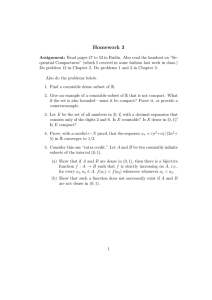
![18.125 Homework 10 : [0, 1] → [0, 1]](http://s2.studylib.net/store/data/010491524_1-2ff13645829ce7088147b1ea2705ee77-300x300.png)
